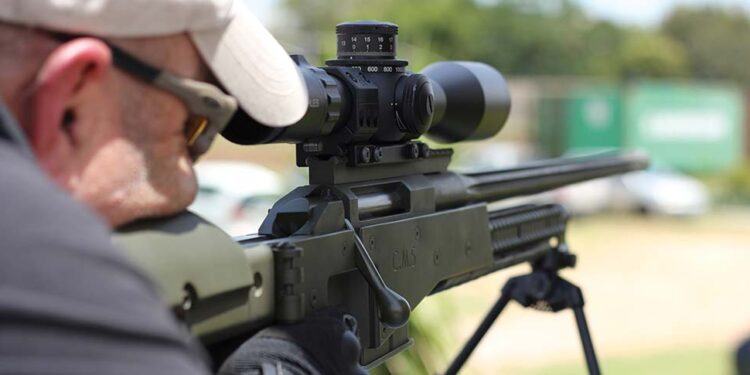By David Lake
Truvelo Manufacturing began in the 1960s in South Africa, manufacturing electronic devices. In 1994, the Truvelo Armoury branch was formed and entered into the manufacture of high-quality rifle barrels and bolt-action receivers. Their market share included both civilians and military and government agencies. As their processes and capabilities continued to improve and expand they unveiled a complete line of professional grade precision rifles. The selection of precision long-range rifles from Truvelo demonstrates supreme quality and performance. Truvelo has garnered our full attention by implementing robust design and a rare measure of practical thinking in the creation of their rifles… which are now available for sale in the United States.
The Truvelo Counter-Measure Sniper rifles (CMS) meet the demands of the professional marksman in the roles of anti-personnel and anti-materiel interdiction. These rifles are available in 6 calibers (though some are restricted); .308 (7.62 NATO), 338 Lapua Magnum, 50 BMG (12.7×99), 14.5×114 soviet, 20x82mm, and 20x110mm. Assuredly, almost any stationary target at an identifiable distance can be successfully engaged with one of these weapons. The 7.62 can be used to good effect on soft targets and unarmored combatants out to 800 yards. At the extreme, the 20×110 fires a 2000 grain projectile at 2800 fps and generates 35,000 ft/lb of energy on target. This rifle can be expected to hit and penetrate… and maybe destroy hardened and armored targets at 2500 yards. The 20mm projectile is large enough to carry a significant payload, which can offer “enhanced effect” on target- to include high-explosive, armor-piercing incendiary, and the indiscriminate crowd-pleaser, the SAPHEI (semi armor-piercing high explosive incendiary).

The rifles displayed herein represent the 3 smallest offerings- the 7.62, .338, and .50 BMG which are available on the retail market. We assume these will be the most commonly demanded, thus most commonly encountered by the armed professional and well-informed sportsman. At first encounter, the Truvelo rifles are intimidating. They’re heavy and thick. The lines and contours are abrupt and totally utilitarian. But at close inspection and in operation, we found these rifles to be refined- care and attention were given to the details. The machining and final finish on all metal parts is perfect and smooth. The fit of all components is tight and seamless. There’s no rattle or wobble in these rifles. The bolt opens with a solid, audible crack- then glides through the receiver smoothly. The bolt does not ride in broach-cut races, as most bolt actions do- it runs through a perfectly smooth cylindrical bore cut through the receiver. The round bolt body is fully supported around its circumference so it cannot bind or tilt during operation. The bolt is helically fluted- this extra machine operation lets the bolt make less contact with the receiver bore, for reduced friction, while providing an escape path for debris and particulate matter that may settle in the receiver. The bolt’s lugs are cut into the diameter of the bolt body (rather than protruding from it). This configuration allows for the simple cylindrical receiver bore. There are 4 locking lugs- so the bolt handle only requires a 40 degree rotation for operation. It’s strong, positive and fast. The extractor and ejector are larger than they need to be- in support of the design ideas behind these over-built rifles.
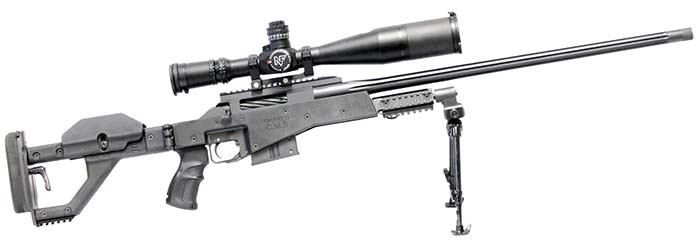
The receiver-mounted Picatinny scope rails are machined from steel and include a third degree forward tilt (20 MOA) for long range zeroing capabilities. Also being over-engineered, the scope mount rails are held on by 6mm socket screws (equivalent to SAE 1/4×28). This mounting should allow the scope to endure triple the shear forces that more “domestic” rifles could never expect to survive. In both design and dimension, the scope mount is overbuilt. It’s much longer than most commercially available mounting options. This extra real-estate makes it versatile and adaptable. The extra mass makes it strong and reliable. It’s also worth noting, that a few years ago there had been some change to the standard Picatinny rail interface- the critical dimensional criteria and tolerances were revised- to allow better clamping consistency and capability, while ensuring reverse compatibility with any accessory designed to the old dimensional standard. This new rail interface has been labeled the NAR, or NATO Accessory Rail. What’s important here is that the Truvelo CMS rifles feature scope rails that fit this new standard.
The trigger mechanism is what we would expect on a professional-grade rifle such as this. The trigger pull offers good feel and feedback- without being overly sensitive. The pull weight approaches 4 pounds and the take-up is longer than most “match grade rifles” would exhibit. At the same time the trigger is not handicapped by any sort of roughness or inconsistency. This kind of trigger pull expects the operator to be committed and in tune to his task and deliberate in his choice of action. It’s the right piece of hardware on rifles such as these. It’s fully adjustable, should the user find any room for improvement. The safety lever is located just ahead of the trigger blade inside the trigger guard. The way it’s situated makes it almost impossible to forget to deactivate the safety before taking a shot. The thoughtful design of the safety basically lets the operator keep the gun on safe, until his finger approaches the trigger to fire. By doing so, the safety is automatically bumped into the “fire” position by the trigger finger. It’s a very positive safety with fast passive control. The control lever for the detachable magazine is integrated into the profile of the trigger guard- so the “shooting” hand can drop the mag while the free hand is retrieving or replacing the magazine. The magazine release lever does take considerable effort to operate. This protects against accidental mag drop during handling.

The stock of the CMS is not totally unique- it’s just good technology- and probably derived as a common conclusion by most designers and users of precision rifles. It consists of an alloy substructure that houses and connects the barreled action, trigger-guard and detachable magazine box, furniture panels, and folding mechanism for the stock. The substructure protrudes from the front end of the plastic enclosure to present a 3 rail accessory boom and a spigot for a quick-detach swiveling Gibbs bipod. The grip seems to be borrowed from the AK pattern rifle. The folding and adjustable stock is standard to all Truvelo CMS rifles. The locking hinge mechanism is very solid- as stated before, there’s no wobble anywhere. The button is easy to actuate to unlock from the open position. And as long as the bolt handle is lifted, the stock will lock into its forward folded position. The requirement to lift the bolt handle ensures that a loaded rifle is not placed in storage or transport. The action of deploying the stock from the stowed position is not as quick- the user must lift up on the butt assembly then swing it out and back- this action takes a bit more strength than folding. The cheek rest is not infinitely adjustable- it can be locked into a number of mechanical notches- spaced about ¼” apart. Though the user may not be able to access just that perfect height, this arrangement is very solid- and cannot slip out of location. That is a welcome compromise. The buttpad is adjustable vertically by means of a rotating locking lever. It can be adjusted (with the free hand, in firing position) approximately 1” up and 1” down from its central location. This aspect does indeed allow a user to match the rifle to his unique body geometry- the proportion of the head, neck, and shoulder. The stock features an accessory rail at the ventral edge for affixing a rear monopod.
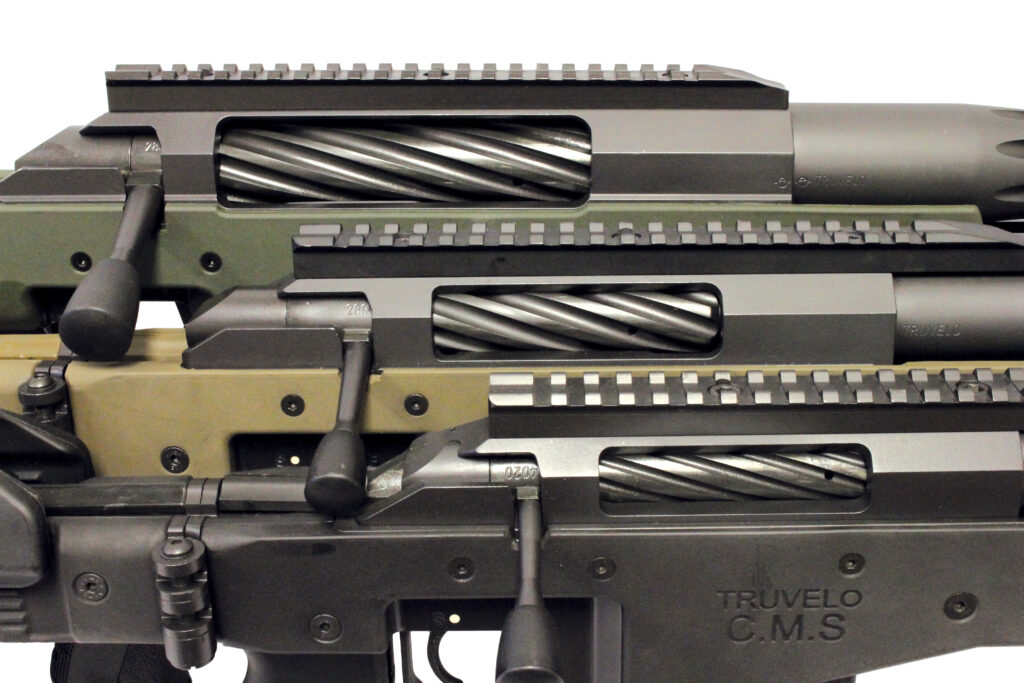
Truvelo Armoury cut its teeth making rifle barrels- from .22 up to 40mm. They are a premier OEM supplier to many other arms manufacturers worldwide. And of course, the CMS rifles all come outfitted with the best Truvelo can muster. Their own rifles however, get an extra dose of “special.” All CMS barrels are fluted- heavily. The 8 groove pattern is aggressive in pursuit of material removal. And that’s what is required to make fluting worthwhile. Most gun manufacturers put fluting there for looks while Truvelo gets after it and makes the grooves deeper than they are wide. Now let’s kill the misconception- fluting does not make a barrel stiffer (than unfluted of the same size). The process of removing longitudinal sections of barrel steel is used as a means to affect some weight savings while maintaining most of the original rigidity. So comparatively, a fluted barrel is stiffer than a non-fluted barrel of the same weight and length. And a fluted barrel is lighter than a non-fluted barrel of the same length and diameter (but not more rigid). That said- these rifles are not lightweight by any means. Truvelo barrel contours exceed what American brands might call a bull barrel. The “root” of the barrel- the section that meets the receiver is about 25% larger than some mainstream American brands. So even with the weight loss from the deep fluting, these barrels are still heavier- and thus stiffer than any mass produced big brand rifle on the shelf today. Adding a lot of extra metal is the wise caveman’s approach to making an accurate rifle.
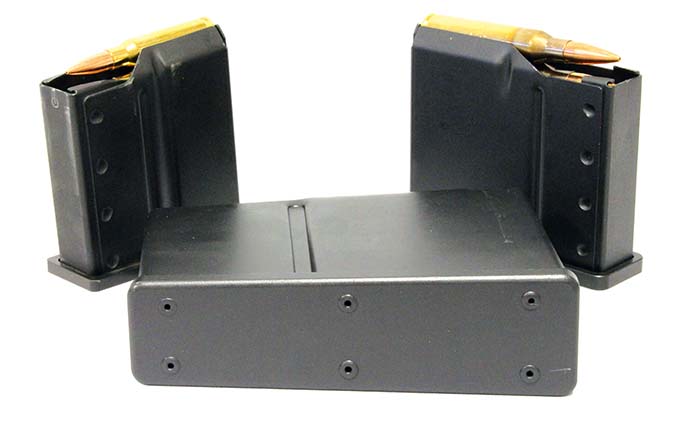
The 7.62 is the only CMS that is not born with a muzzle brake. The muzzle is threaded to accept a suppressor. The 7.62 has moderate recoil, and lends itself well to dedicated suppressed use with full-power or short range subsonic ammunition. The muzzle brakes on the .338 and .50 are good designs that boast 60% reduction in felt recoil. Without access to an appropriate laboratory and equipment to prove that claim, we were content to just shoot the rifles. All we can confirm is that the muzzle brakes are more than adequate; the recoil forces produced by these rifles are very manageable. The .338 produced no more felt impulse than the 7.62 rifle. The recoil from the .50 was like that generated by a 12-gauge firing a full-power 3.5” magnum shell. Stout recoil, yes. But very controllable and not totally unbearable. Considering that this is a fixed breech rifle, recoil force is always going to be higher than a semi-automatic.
The included Gibbs bipod is of the famed Parker-Hale design. These bipods may look old fashioned to some, but don’t be fooled by popular consensus. The Parker-Hale design allows for the user to freely swivel and tilt and pan his rifle (within a narrow field) without being tasked with loosening and tightening locking levers and knobs. The free motion of the Gibbs pod allows a shooter to easily match and track the motion of a moving target or pan and scan a target area. Once presented with a target and firing solution, the sniper need only apply forward pressure to the rifle; this will cause the joints of the bipod to bind up and become quite solid. The legs of the Gibbs bipod are extendable and may be folded forward or backward when stowed. The Gibbs pod only showed weakness while supporting the .50. The rifle, being so heavy, took constant attention to keep it under control. A rifle of this bulk and weight may need a more rigid bipod configuration. But the .308 and .338 could be adequately controlled and stabilized with the rear support hand.
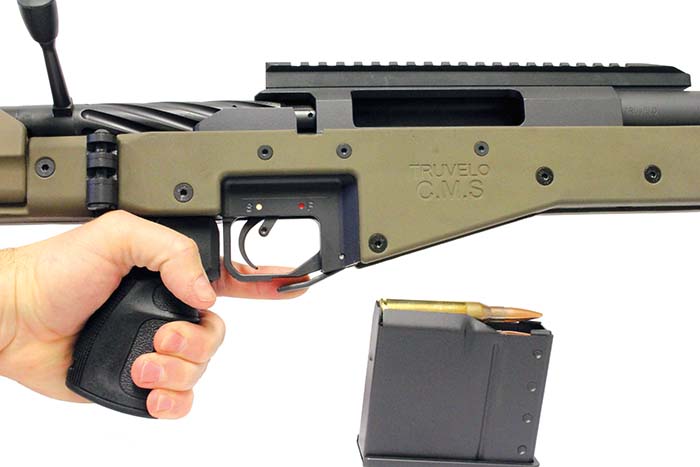
We tried firing the CMS 7.62 and .338 off-hand but found it difficult to maintain good control and balance. We could not utilize the ideal forward hand position- the Picatinny accessory boom occupies that space. With the exception of the 7.62 version, these rifles are too heavy to fire free-handed anyway. These rifles definitely favor a rested firing position. So again, that’s a compromise we can accept. Truvelo did allude that there may be forearm options in the works- possibly extra panels that can be attached over the Picatinny accessory boom to form a more conventional profile.
Putting the Truvelo rifles to work was a special opportunity. As staff of Small Arms Review, we get to field test many types of weaponry. The Truvelos stood out among other precision rifles we’ve spent time with. The heft and quality feel of these rifles seems to instill the operator with an added boost of confidence. We would employ premium ammunition to demonstrate the accuracy potential of these weapons. The .308 fired Black Hills Match with a 168 grain Match King. The .338 was also fired with Black Hills Match ammo- with the 300 grain Match King bullet. Hornady Match with a 750 grain A-Max pill was fed to the .50 caliber. We used our best judgment (referring to the twist rate of the barrels) for bullet weight selection, and relied on the reputation for quality from these 2 ammo manufacturers. All three rifles were fitted with the Nightforce BEAST scope for testing. Considering that the scope is the only connection the rifle and target share- a rifle’s potential for excellence can only be viewed through perfect glass. The Nightforce is unmatched and would allow us to exploit the Truvelo’s talent. The Beast goes way above and beyond. We found its clarity and resolution to exceed our Kowa spotting scope. The reticle’s subtensions and click corrections are absolutely accurate.
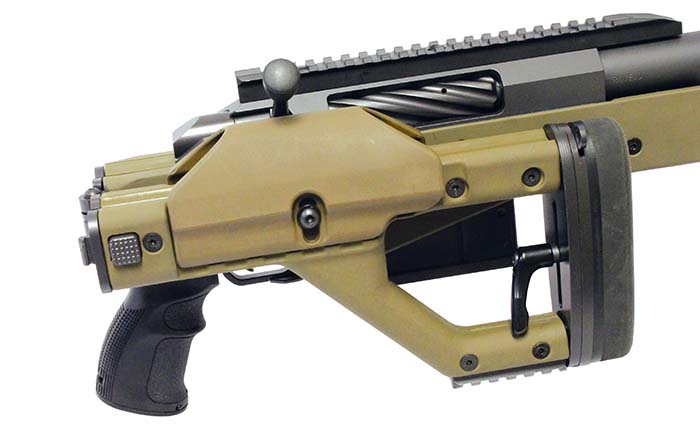
We had assumed that at this level of expected quality, the Truvelo would “just shoot” and not exhibit a tendency to favor a certain ammunition type (which is usually the case among small arms manufacturers). Our range day would take us into the vast open of the southern Utah desert on the day after a storm. The sky was still overcast, so no mirage to deal with and the wind had blown itself out- we had perfect conditions. Given such a perfect day, the “Truvelo Trio” performed famously. All returned sub MOA accuracy on a paper target at 300 yards. We engaged a hanging 12”x18” steel plate at 600 yards; all three rifles found this test too easy. At 850 yards the .308 gave up 30% of its hits to waning bullet stability. With the .338 and .50 we were able to continue to ring the 12×18” at 1200 yards. The .50 begged for more, so we took her to task on that same steel at 1600 yards. At this distance- just shy of a mile- a successful shot indeed owes much to the shooter. But indeed, the shooter owes as much to his rifle and scope. Without embellishment, we connected with that 12”x18” plate at 1600 yards on the fourth attempt. At that range the sound of the impact could not be heard- but the energy of the 750 A-Max made visible effect on target.
It is becoming obvious that there are too many “sniper” rifles made for the masses that just miss the mark when it comes to the why and the how of the engineering and final execution. The market has become diluted with hobby-level hardware and mediocre quality – all displayed as the next tactical fashion trend or promoted as the new “game-changer.” Considering the plethora of long-range precision rifles we’ve been able to review, Truvelo rifles will be counted among the best. Truvelo gives us hope- they have not lost sight of real purpose for their craft. Truvelo rifles demonstrate perfectly simple rock solid utilitarian design in long-range weapon that can support the demands and exploit the abilities of even the best shooter.
In the United States, Truvelo 7.62 x 51mm, .338 Lapua Magnum, and .50 Cal BMG rifles are available from Gun Mountain LLC, 410 Marks St, Henderson, NV 89014 Tel: 702-564-3272 website: www.gunmountain.com
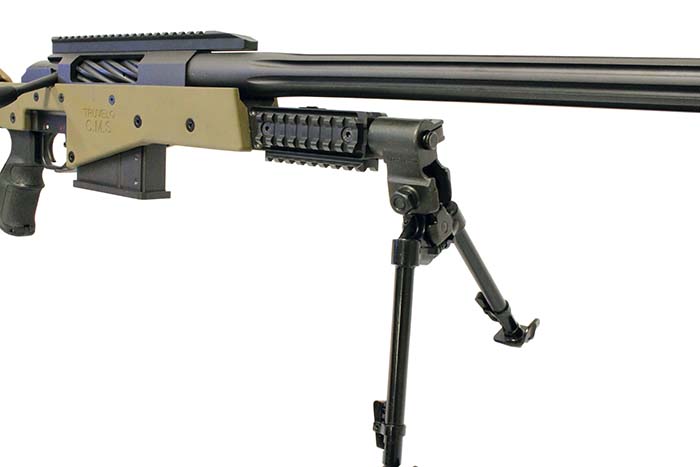
| This article first appeared in Small Arms Review V20N6 (July 2016) |



